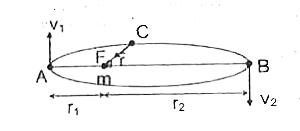A comet orbits the sun in a highly elliptical orbit. Does the comet have a constant (a) linear speed (b) angular speed ( c) angular momentum (d) Kinetic energy ( e) potential energy (f) total energy throughout its orbit? Neglect any mass loss of the comet when it comes very close to the sun.
A comet while going on elliptical orbit around the sun has constant angular momentum and total energy at all locations but other quantities very with locations.
Topper's Solved these Questions
- GRAVITATIONBOOK - VGS PUBLICATION-BRILLIANTCHAPTER - GRAVITATIONEXERCISE - PROBLEMS
15 Videos
- FLOATING BODIESBOOK - VGS PUBLICATION-BRILLIANTCHAPTER - FLOATING BODIESEXERCISE - OBJECTIVE TYPE QUESTIONS
40 Videos
- HUMAN EYE AND COLOURFUL WORLDBOOK - VGS PUBLICATION-BRILLIANTCHAPTER - HUMAN EYE AND COLOURFUL WORLDEXERCISE - CREATIVE QUESTIONS FOR NEW MODEL EXAMINATION (SECTION-IV) (APPLICATION TO DAILY LIFE, CONCERN TO BIODIVERSITY)
1 Videos
Similar Questions
A comet orbits the Sun in a highly elliptical orbit. Does the comet have a constant (a) linear speed (b) angular speed (c) angular momentum (d) kinetic energy (e) potential energy (f) total energy throughout its orbit? Neglect any mass loss of the comet when it comes very close to the Sun.
View SolutionA planet is revolving around the sun in an elliptical orbit. Which out of the following remains constant.
(a) Linear speed (b) angular momentum
( c) kinetic energy (d) potential energy (e) total energy throughout its orbit.
View Solution
Knowledge Check
A comet is revolving around the sun in an elliptical orbit. Which of the following will remain constant throughout its orbit?
AKinetic energyBPotential enegyCLinear speedDAngular momentumA planet is moving in an elliptic orbit. If T,V,E and L stand, respectively, for its kinetic energy, gravitational potential energy, total energy and angular momentum about the centre of force, then
AT is conservedBV is always positiveCE is always negativeDmagnitude of L is conserved but its direction changes continuously
A planet is revolving around the sun in an elliptical orbit. Which out of the following remains constant.
(a) Linear speed (b) angular momentum
( c) kinetic energy (d) potential energy (e) total energy throughout its orbit.
View SolutionIn the figure shown a planet moves in an elliptical orbit around the sun. Compare the speeds, linear and angular momenta at the points A and B.

View SolutionIn the figure shown a planet moves in an elliptical orbit around the sun. Compare the speeds, linear and angular momenta at the points A and B.

View SolutionA star like the sun has serveral bodies moving around it at different distance. Consider that all of them are moving in circular orbits. Let r be the distance of the body from the centre of the star and let its linear velocity be υ, angular velocity ω, kinetic energy K, gravitational potential energy U, total energy E and angular momentum L. As the radius r of the orbit increase, determine which of the above quantities increase and which ones decrease.
View SolutionA star like the sun has serveral bodies moving around it at different distance. Consider that all of them are moving in circular orbits. Let r be the distance of the body from the centre of the star and let its linear velocity be υ, angular velocity ω, kinetic energy K, gravitational potential energy U, total energy E and angular momentum L. As the radius r of the orbit increase, determine which of the above quantities increase and which ones decrease.
View SolutionA planet is moving in an elliptic orbit. If T,V,E and L stand, respectively, for its kinetic energy, gravitational potential energy, total energy and angular momentum about the centre of force, then
View Solution
